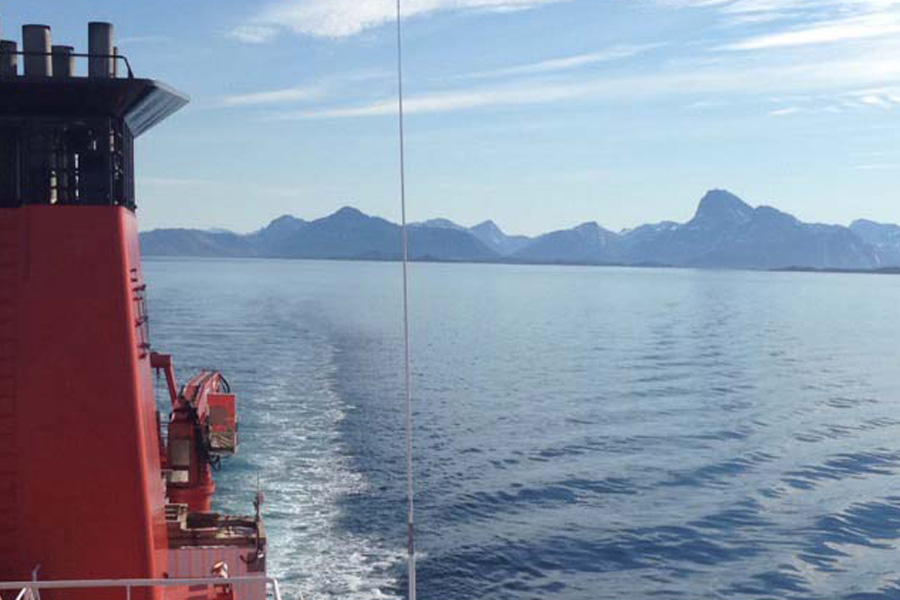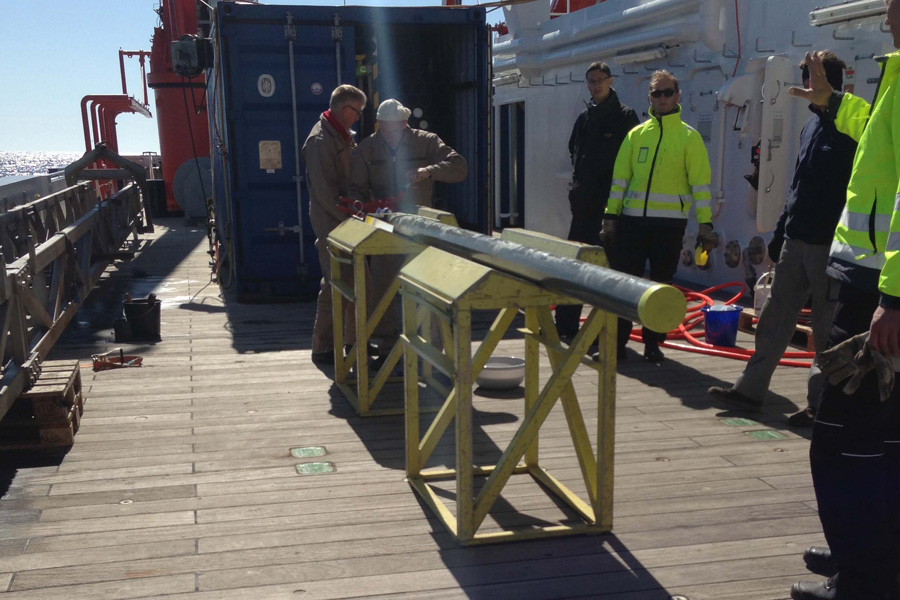Nach einem kurzen Besuch von Nuuk, der Hauptstadt von Grönland, brach die Maria S. Merian zu einer dreiwöchigen Forschungsfahrt nach Halifax, Kanada auf. Für viele von uns ist es das erste Mal in den kalten Gewässern der Labradorsee, für einige von uns sogar das erste Mal auf See überhaupt. In den ersten Stunden nach Auslaufen waren alle an Bord aufgeregt, und photographierten Eisberge und die malerischen Berge um Nuuk. Mit ruhiger See und sonnigem Himmel hätten wir uns keinen besseren Auftakt der Expedition wünschen können.
An Bord sind 21 Wissenschaftler von beiden Seiten des Atlantiks, aus Deutschland, Frankreich, Belgien, Kanada und Peru. Wir sind eine gemischte Truppe von Kerntechnikern, Postdocs, Professoren, und Bachelor-Studenten, und können so während der Ausfahrt noch viel voneinander lernen. Mit uns an Bord ist eine 24-köpfige Crew, die das Schiff führen, die Geräte bedienen und uns den Aufenthalt an Bord so angenehm wie möglich machen.
Ein Tag auf See beginnt normalerweise mit Frühstück um 7:30 in der Messe. Hier wird der Arbeitsplan für den Tag erläutert, und Seefahrts-Neulinge erhalten Einführungen und letzte Instruktionen. Nach dem Frühstück arbeiten wir in verschiedenen Gruppen: Wasserbeprobung, Sedimentbeprobung, Biologie, und Kerngeräte. Zudem gibt es ein Hydroakustik-Team, das den Meeresboden nach idealen Kernpositionen absucht. Wenn die Merian dann die Beprobungsstation erreicht hat, werden die Instrumente eins nach dem anderen zu Wasser gelassen.
Zur Beprobung der Wassersäule benutzen wir ein Planktonnet um die kleinsten Bewohner der Labradorsee zu „fischen“ und einen Wasserkranzschöpfer, um Wasserproben zu entnehmen. Während der Wasserkranzschöpfer vom Schiff durch die Wassersäule gefiert wird, zeichnet er Temperatur, Salzgehalt (Salinität), Sauerstoffkonzentration und Chlorophyllgehalt auf, an Hand derer die Wissenschaftler an Bord die verschiedenen Wassermassen identifizieren können. Sobald der Wasserkranzschöpfer so die ganze Wassersäule vermessen hat, wird er wieder gehievt und während des Aufstiegs werden einzelne Flaschenproben aus den verschiedenen Wasserstockwerken genommen. Diese werden dann an Bord für Analysen zuhause im Labor abgefüllt und beschriftet.
Vier verschiedene Geräte kommen bei der Beprobung des Meeresbodens zum Einsatz: Großkastengreifer und Multicorer beproben die Sedimentoberfläche, während mit dem Schwerelot und dem Kolbenlot 5-20m lange Kerne genommen werden. Sobald die Kerne an Deck sind, werden sie aufs gründlichste beschriftet beschrieben und beprobt. Die Sedimentbeprobung findet immer erst dann statt wenn die Wassersäulenbeprobung abgeschlossen ist, damit es nicht zu Kontaminationen kommt.
Bis all diese Geräte an einer Station zum Einsatz gekommen sind, vergehen meist viele Stunden manchmal sogar ein ganzer Tag. Die Arbeit an Deck wird dabei pünktlich von Kaffeepausen und Mittag- und Abendessen unterbrochen. Und nach getaner Arbeit ist stets noch Zeit die ruhige See im Sonnenuntergang zu genießen.
Heute haben wir erfolgreich unsere erste Station der Expedition MSM45 abgeschlossen. Wir sind guter Stimmung und hoffen auf weiterhin ruhige See.
[English]
A Day in the Life – Science At Sea
After a quick visit to Nuuk, the capital of Greenland, the MARIA S. MERIAN departed for the beginning of our three-week research expedition to Halifax, Canada. For many of us it is our first time in the cold waters of the Laborador Sea, and for some it is the first time at sea altogether. In the first few hours after leaving port, the upper deck was filled with excited scientists taking shots of drifting icebergs and the picturesque mountain range that surrounds Nuuk. With calm seas and a sunny sky, we couldn’t have asked for a better day to start our cruise!
Among us are twenty-one scientists that come from both sides of the Atlantic Ocean, including Germany, France, Belgium, Canada, and Peru. Our experience ranges from core technician, to professor, to bachelors student, making us a very diverse group with a lot to learn from each other over the duration of the cruise. We are also joined by 24 crewmembers that work hard each day to operate the ship and provide a great quality of life for everyone on board.
A typical day of life at sea aboard the M.S. MERIAN begins with breakfast at 7:30 am in the meal room. This is a great time to discuss the day’s plan with colleagues and share expertise with those who are new to sampling protocol at sea. After breakfast, we break into assigned groups to prepare for the day’s sampling operations. These groups include water sampling, sediment core sampling, plankton sampling and gear handling. There is also a hydroaccoustics group that works shifts to survey the seafloor in search of ideal locations for sediment sampling. Once the ship has moved into position for a station, the sampling instruments are lowered successively into the water column or to the seafloor.
When sampling the water column we use a plankton tow and an instrument called a CTD-rosette, which stands for Conductivity (a proxy for salinity), Temperature, and Depth. This instrument is essentially lowered through the water column and records a depth profile of temperature, salinity, and additional parameters such as oxygen and chlorphyll content. The scientists that are part of the water sampling team analyze these depth profiles to identify the different water masses present at the station. They then raise the CTD-rosette slowly and send messages to the instrument to collect bottles of seawater when it reaches each depth of interest. It is then brought back onto the ship, where the bottles are subsampled for analysis back on land.
When sampling the seafloor we use four different types of coring devices: the Giant Box Core is used to sample surface sediments, multicores are used to sample the sediment-water interface, and gravity and piston cores are used to collect 5-20 m long samples of the seafloor. Once the cores are out of the water, they are characterized and sampled on deck. These devices are deployed after the water sampling is complete in order to ensure that the water column is not disturbed before being characterized.
The time it takes to sample at a single station ranges from a few hours, to all day. Therefore we break up the work by meeting for coffee in the morning and afternoon, as well as for 11:30 lunch and 5:30 pm dinner. After all the work is complete, there is plenty of time to relax and enjoy the quiet nights at sea.
Today, we all worked hard and successfully completed sampling at the very first station of MSM45. We are in good spirits and certainly hope things remain this smooth for the rest of the cruise!

